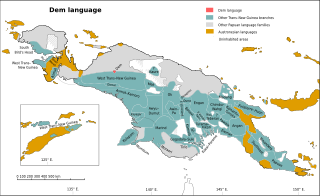Related Research Articles
The Lakes Plain languages are a small family of Papuan languages. They are notable for being heavily tonal and for their lack of nasal consonants.
The Ramu–Lower Sepika.k.a.Lower Sepik–Ramu languages are a proposed family of 35 Papuan languages spoken in the Ramu and Sepik river basins of northern Papua New Guinea. These languages tend to have simple phonologies, with few consonants or vowels and usually no tones.
The Sepik languages are a family of some 50 Papuan languages spoken in the Sepik river basin of northern Papua New Guinea, proposed by Donald Laycock in 1965 in a somewhat more limited form than presented here. They tend to have simple phonologies, with few consonants or vowels and usually no tones.
The Yuat languages are an independent family of five Papuan languages spoken along the Yuat River in East Sepik Province, Papua New Guinea. They are an independent family in the classification of Malcolm Ross, but are included in Stephen Wurm's Sepik–Ramu proposal. However, Foley and Ross could find no lexical or morphological evidence that they are related to the Sepik or Ramu languages.

Porome, also known as Kibiri, is a Papuan language of southern Papua New Guinea. There are over a thousand speakers.
Tause, also known as Doa or Darha, is a poorly known Papuan language of Indonesia spoken by some 350 people. The Tause only made contact with the outside world in 1982. Their language has been widely reported to be related to the neighboring Lakes Plain languages; however, this conclusion is based on little evidence. Ross (2005) placed Tause in his East Bird's Head – Sentani family, along with another language isolate and two small families, but this was motivated more by an attempt to spark further research than an actual claim of relationship. Usher (2018) classifies it as the most divergent of the West Lakes Plain languages.

The Kiwaian languages form a language family of New Guinea. They are a dialect cluster of half a dozen closely related languages. They are grammatically divergent from the Trans–New Guinea languages, and typically have singular, dual, trial, and plural pronouns.

The Fasu language of New Guinea is not closely related to other languages but forms a possible branch of the Trans–New Guinea (TNG) family. Wurm and Hattori (1981) considered its three principal dialects, Fasu, Some and Namumi, to be three languages, which they called the West Kutubuan family, but Glottolog considers it a single language. It is not particularly close to the two East Kutubuan languages.

The Bosavi languages are a family of the Trans–New Guinea languages in the classification of Malcolm Ross.
The Walio languages are a small family of clearly related languages, Walio, Pei, Yawiyo, and Tuwari, though they are not close: Walio and Yawiyo have only a 12% lexical similarity. They are frequently classified among the Sepik languages of northern Papua New Guinea, though Glottolog leaves them out.
Hattam is a divergent language of New Guinea. Apart from Mansim (Borai), formerly listed as a dialect, it is not closely related to any other language, and though Ross (2005) tentatively assigned it to the West Papuan languages, based on similarities in pronouns, Ethnologue and Glottolog list it as a language isolate or small independent family.
Abun, also known as Yimbun, Anden, Manif, or Karon, is a West Papuan language spoken along the northern coast of the Bird's Head Peninsula. It is not closely related to any other language, and though Ross (2005) assigned it to the West Papuan family, based on similarities in pronouns, Ethnologue and Glottolog list it as a language isolate.

Dem is a possible Trans–New Guinea language in the classification of Malcolm Ross (2005). A small number of words connect it to other language families of the Irian Highlands, but they are not consistent correspondences, and it is not clear what they mean. The only pronouns which have been recorded are 1sg nau, 2sg aŋ, and 1pl yu.

Sumuri or Sumeri is a language spoken on the Bomberai Peninsula by about a thousand people.

Pawaia, also known as Sira, Tudahwe, Yasa, is a Papuan language that forms a tentative independent branch of the Trans–New Guinea family in the classification of Malcolm Ross (2005). Although Pawaia has reflexes of proto-Trans–New Guinea vocabulary, Ross considers its inclusion questionable on available evidence. Usher classifies it instead with the Teberan languages.
The Orya–Tor languages are a family of Papuan languages spoken in Indonesia.
Brem (Barem), also known as Bunabun, is a Papuan language of Madang Province, Papua New Guinea.
KambotAKAAp Ma, is a Ramu language of Papua New Guinea of unclear affiliation.
Musar, also Aregerek and Vanembere, is a Papuan language of Madang Province, Papua New Guinea.
References
- 1 2 "WALS Online -". wals.info. Retrieved 2018-08-18.
- 1 2 Hammarström, Harald; Forkel, Robert; Haspelmath, Martin, eds. (2017). "Mpur". Glottolog 3.0 . Jena, Germany: Max Planck Institute for the Science of Human History.
- ↑ Amberbaken at Ethnologue (21st ed., 2018)
- ↑ Muysken, Pieter. From Linguistic Areas to Areal Linguistics. John Benjamins Publishing Company. p. 134. ISBN 9789027231000.
